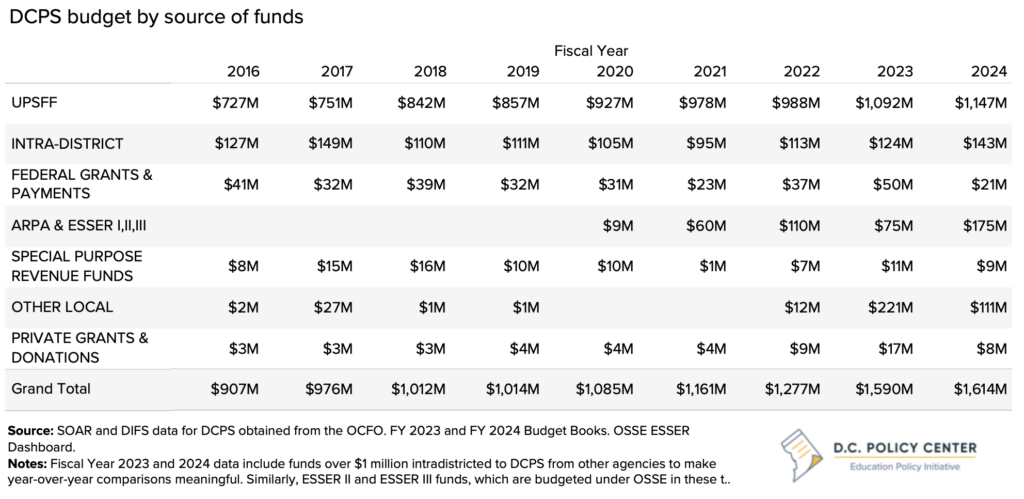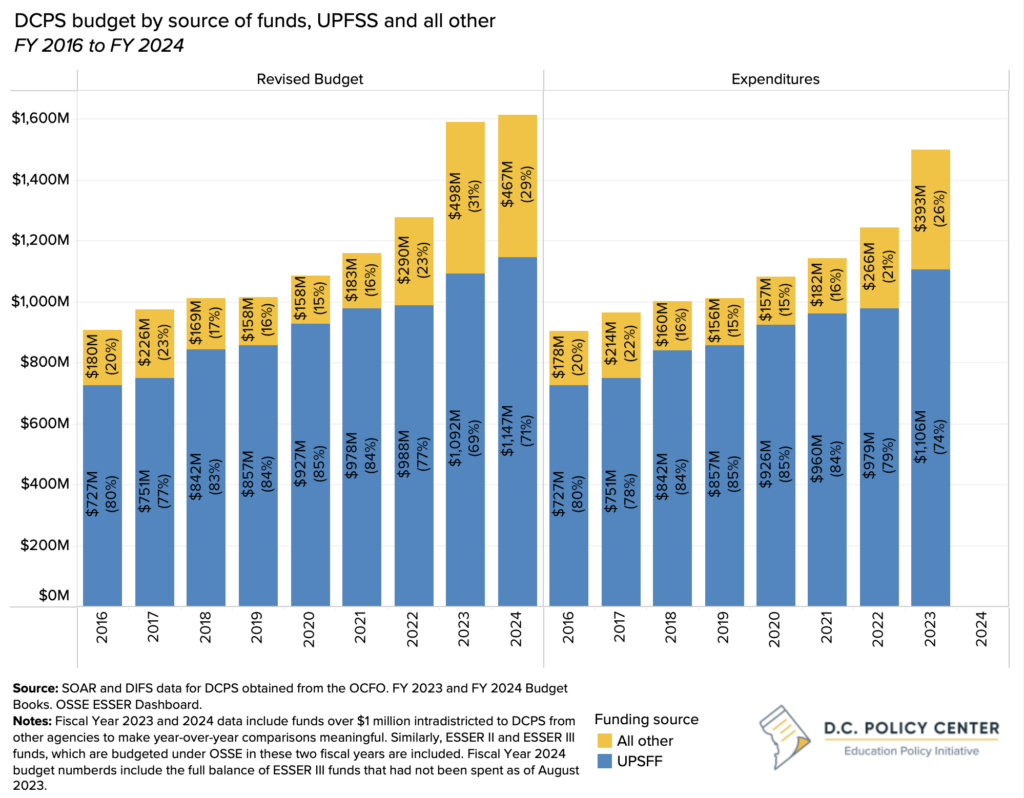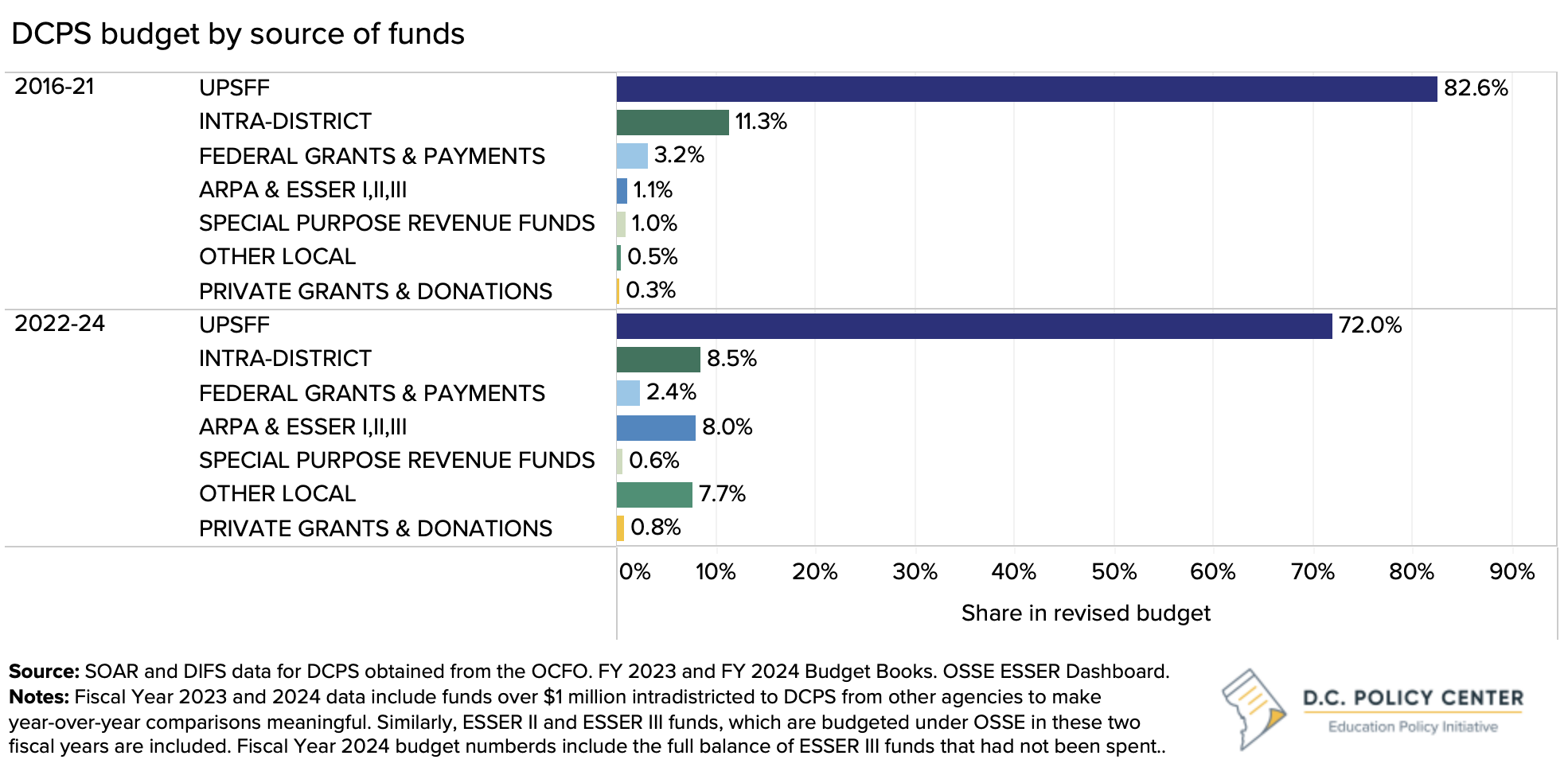

On November 14, 2023, Executive Director Yesim Sayin testified at the Committee of the Whole’s Oversight Hearing on District of Columbia Public Schools (DCPS)’s budgeting practices. The testimony focuses on the increasing reliance of DCPS on non-formula funds, the budget pressures DCPS will face beginning Fiscal Year 2025 when most of these funds will disappear, and how these pressures will make it extremely difficult to continue current budgeting practices, including the practices required by the Schools First in Budgeting Act (DC Act 24-722). You can read her testimony below, or download a PDF copy.
Good afternoon, Chairman Mendelson and members of the Committee of the Whole. My name is Yesim Sayin and I am the Executive Director of the D.C. Policy Center—an independent non-partisan think tank advancing policies for a strong, competitive, and vibrant economy in the District of Columbia. I am grateful for the opportunity to testify.
My testimony will focus on the increasing reliance of District of Columbia Public Schools (DCPS) on non-formula funds, the budget pressures DCPS will face beginning Fiscal Year 2025 when most of these funds will disappear, and how these pressures will make it extremely difficult to continue current budgeting practices, including the practices required by the Schools First in Budgeting Act (DC Act 24-722).
In Fiscal Year 2024, the Unified Per Student Funding Formula (UPSFF)—the main funding tool for DCPS—is accounting for only 71 percent of resources DCPS is receiving.
In Fiscal Year 2024, DCPS is projected to receive $1,147M from formula funds. That year, it will also receive $52.9M in other local funds outside the formula. These include money the Executive set aside for the 95 percent safe harbor goal for individual school budgets, various pandemic supports, and money for IMPACT bonuses, at-risk concentration, and the Early Stages Initiative. Federal grants and payments ($44.0M), private grants ($8.3M), and special purpose revenue funds ($8.9M) bring the total DCPS budget to $1,261M.
In addition, DCPS will receive resources that are budgeted elsewhere. The first group is the intra-district resources—money that lives in other agencies’ budgets but will be sent to DCPS. The city’s new budgeting practices no longer allocate these funds to DCPS. But the budget book has a summary of intra-district funds over $1M that DCPS anticipates receiving. These add up to $143.5M.
Second, DCPS will benefit from $57.7M set aside for teacher pay increases that resulted from the WTU contract (paid for by a combination of Workforce Investment Funds and American Rescue Plan Act, or ARPA funds).
Third, DCPS will have access to the Elementary and Secondary School Emergency Relief (ESSER) III funds that it did not spend by the end of August 2023. This is an additional $151.7M. These are also budgeted elsewhere but I separated them from the rest of the intra-district funds because these funds will expire at the end of Fiscal Year 2024.
With these amounts, the total resources allocated to DCPS in Fiscal Year 2024 is at least $1,613M.
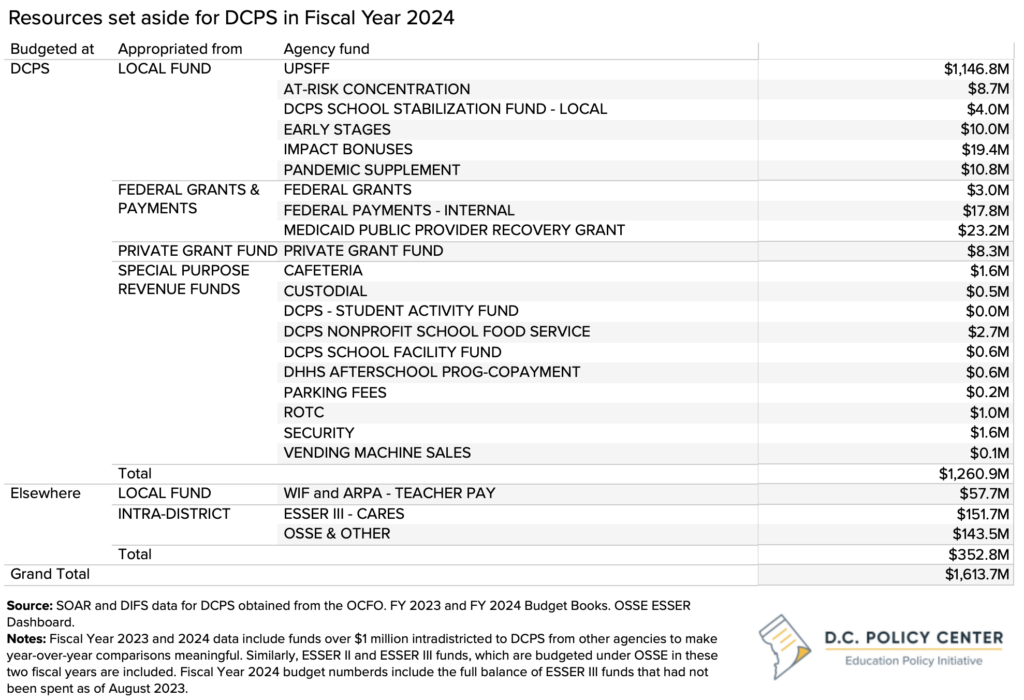

Formula funding is increasingly paying a smaller share of DCPS’s overall budget.
Between Fiscal Years 2016 and 2021, formula funds made up 82 percent of resources set aside for DCPS (including the intra-district funds). Since then, this share has decreased to at most 72 percent. (The detailed table is in the appendix).
The share of resources intra-districted from other agencies declined from 11.3 percent to 8.5 percent. But Fiscal Years 2023 and 2024 numbers are likely higher than what I could find from publicly available data sources since DCPS only reports a non-comprehensive list and excludes intra-districted funds under $1M.
Prior to Fiscal Year 2022, the share of local funds DCPS received outside the formula was minor, accounting for about half a percent of all resources (including funds transferred from Contingency Reserves to close budget gaps – $29M for the entire period), and some money for school food services contract. Since then, the share of out-of-formula local funds has ballooned to 7.7 percent. The city is using out-of-formula local funds to pay for teacher pay increases, bonuses associated with IMPACT evaluations, school budget stabilization that cannot be afforded by the formula, pandemic supplement funds, and money for schools with high concentration of at-risk students.
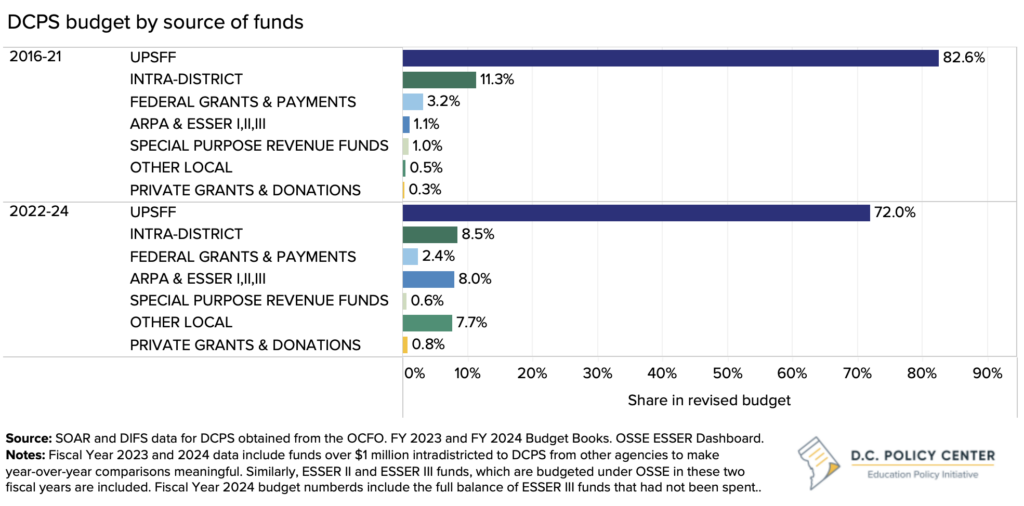

Another big change is pandemic-related federally funded transfers to DCPS including funds from ARPA and the third round of ESSER allocations. These accounted for 8 percent of DCPS resources between Fiscal Year 2022 and 2024. Since Fiscal Year 2020, as best as I can tell, DCPS received $429 million from these pandemic-related federal aid dollars, and of this amount, $359M have supported DCPS in the last three fiscal years including Fiscal Year 2024. There are other things paid for by pandemic-related federal aid that is not directly allocated to schools, such as money for career related programs and high impact tutoring, or federal fiscal aid that was converted into local revenue to pay for general operating expenditures. Some of these are collapsed under intra-district in the chart, and others are impossible to track.
In the last two fiscal years, resources available to DCPS grew much faster than what it has received through formula funds.
This holds true even one removes intra-district funds and the one-time contribution the city made in Fiscal Year 2023 to pay for back-pay obligations associated with the WTU contract. In Fiscal Year 2023, the total resources available for DCPS (with the two aforementioned exclusions) grew by $154M, or 13 percent. That year, resources from the funding formula increased by 11 percent. In Fiscal Year 2024, total resources grew by 12 percent, but formula resources grew by only 5 percent.
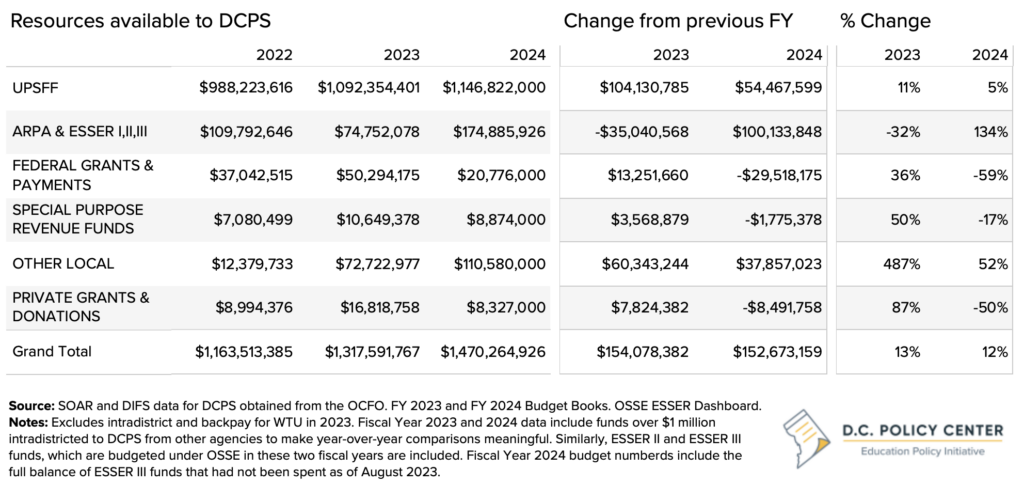

The heavy reliance on out-of-formula funds and federal fiscal aid will make FY 2025 budgeting extremely difficult.
In Fiscal Year 2025, federal fiscal aid will expire. This is a loss of $174.8M. Additionally, the city’s financial plan accounts for $66M for WTU related pay increases, but it does not account for the additional $44 million that DCPS received outside of the formula. That is, the baseline FY 2025 budget for DCPS, excluding intra-district transfers is likely going to be $219 million lower than FY 2024. This is an extraordinarily high amount that cannot be squeezed from the Central office budget. To make up for this loss, formula funds would have to increase by an improbable 19 percent. Even excluding the federal fiscal aid, formula funds would have to increase by 4 percent. To put this number in context, the city’s projected revenue increase for FY 2025 is 2.8 percent.
It is true that the Schools First in Budgeting Act does not require DCPS to make up for the lost federal fiscal aid. But schools will still feel the pressure as they may have to cut staff and other programs they paid for using these resources. The city’s reliance on federal fiscal aid and spending from its previous-year budget surpluses have created significant future budget pressures on the entire District budget. DCPS will feel the same.
Keeping school budgets stable is a worthy goal. But it may just become impossible to achieve in the coming years. Moving forward, the city will have to make tough choices. It is imperative to track (a) where the greatest needs are; (b) what programs will have to be preserved; (c) what needs are the greatest priority in funding; and (d) where DCPS’s internal fund allocation mechanism for different schools and the Schools First Budgeting Act requirements are at odds most often. Thank you for the opportunity to testify. I welcome any questions.
Appendix
